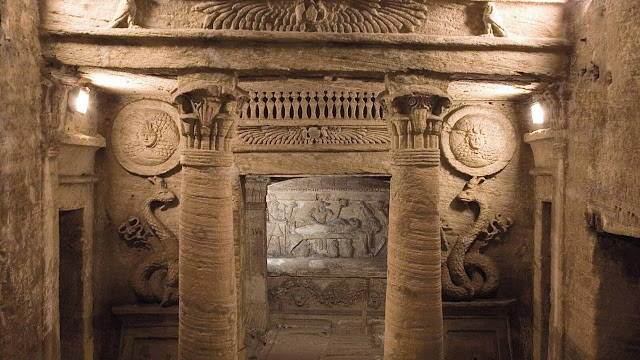Jeita Grotto is actually a cave
system stretches about 9 kilometers into the mountains 18km northeast of
Beirut. Jeita Grotto is one of greatest natural wonders, discovered in 1836 by
Reverend William Thomson; and opened as a tourist attraction in 1969. During
civil war, the caves were used as an ammunition store, now interconnected,
karstic limestone caves are situated in the Nahr al-Kalb valley within the
locality of Jeita. Though inhabited in prehistoric times, the lower cave was
not rediscovered until 1836 it can only be visited by boat since it channels an
underground river that provides fresh drinking water to more than a million
Lebanese. These lower caves are always explored by small boat and are closed
when the flood levels rise too high. However, the extraordinary upper cavern
stays open all year and is explored on foot or via a cable car. It has
strategically positioned colored lights that showcase the stalactites and
stalagmites in all their crystalline glory. Moreover, the upper galleries house
the world's largest known stalactites are composed of a series of chambers the
largest of which peaks at a height of 390 feet.
The Lebanese speleologists
discovered the upper galleries 60 metres above the lower cave in 1958. This has
been accommodated with an access tunnel and a series of walkways to enable tourist’s
safe access without disturbing the natural landscape. In spite of all kinds of
tatty side attractions the site remains a spectacular day trip from Beirut, but
keeps in mind that there’s no photography allowed. Geita Grotto is Lebanese
national symbol and most famous tourist spot, plays an imperative role in
social, economic and cultural player in the country. Geita Grotto was one of
top 14 finalists in the New 7 Wonders of Nature competition.
The Jeita caves are solutional karst caves,
formed more than millions of years due to the dissolution of limestone,
dissolved by carbonic acid charged rain water and groundwater. Thus, when the
limestone, were originally waterproof, contains cracks produced by tectonic
forces the water oozes into the rock and starts to widen the cracks and solute
caves inside the layers Jeita is the longest cave complex in the Middle East
geologically, the caves provide a tunnel or escape route for the underground
river, which is the principal source of Nahr al-Kalb.
The Jeita grotto is the longest
explored cave in Lebanon, hosts approximately 280,000 visitors per year. Moreover,
the Jeita cave emits a spring with a flow ranging from 1–2 m3/s, providing
fresh drinking water for one-and-a-half million inhabitants of the capital,
Beirut. However, water pollution, due to domestic and agricultural runoff,
remains a serious concern as recent analysis detected an increasing presence of
coliform bacteria.
The name of the cave changed many
times since its discovery. Initially it is called as Grottoes of Nahr al-Kalb, also
known as Djaita, Jehita, and finally Jeita meaning “roaring water”. Nahr al-Kalb
is the name of the river that runs through the grottoes. The Jeita grotto
contains a lot of touristic attractions that fill the visitor’s time with
enjoyment and happiness. The main attractions include ropeways, train,
miniature zoo, gardens and many sculptures.

























































